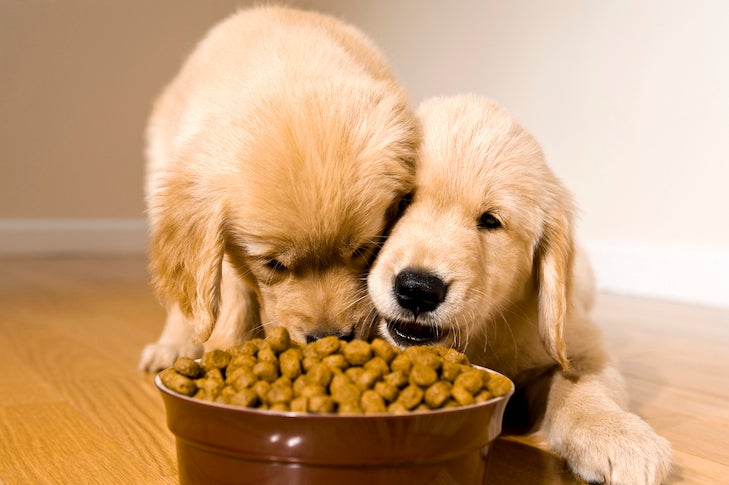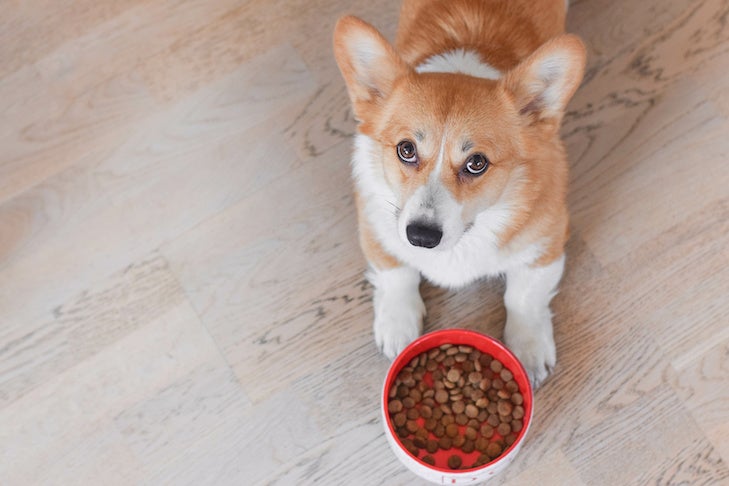Today, there are countless brands, ingredients, and methods of preparation for your dog’s dinner. As a result, dog food myths can sometimes become mainstream mindsets.
Corn is a common and cost-effective dog food ingredient. But what do you need to know about corn in dog food?
Can Dogs Digest Corn?
It’s true that if you’ve got a counter-surfing canine, you’ll want to stop them from eating corn on the cob at your backyard barbecue. The tough cob is a common culprit for life-threatening intestinal blockages in dogs, and they can’t easily digest raw corn.

However, the common belief that corn in dog food is difficult to digest is inaccurate. Canine nutritionist Linda Case explains that dogs can efficiently digest cooked starch from maize (corn) or any other plant starch (just as humans can), with raw starch being about 60 percent digestible compared to about 95 percent for cooked starch.
“The difference occurs because mammalian enzymes do not efficiently penetrate the starch-containing granules of raw starches. However, cooking will expand (gelatinize) these granules, allowing an animal’s digestive enzymes better access to starch molecules so that they can be digested,” says Case.
Corn Isn’t Just a “Filler”
Cooked maize is often touted as being a dog food filler with no nutritional value. Case suggests that this “probably evolved from the truism that corn is an inexpensive and available starch-providing ingredient in pet foods. Because of its low cost, it has tended to make up a relatively high proportion of low-cost brands of dog food.”
But, as part of a balanced diet, carbs like corn have some valuable benefits. Case explains that this digestible source of starchy carbs is primarily a source of energy in the form of calories. She adds that, “depending on the fraction(s) of the corn kernel that are included, it can also provide small amounts of certain vitamins and minerals to the diet.”

Corn is also a valuable source of linoleic acid, an essential fatty acid. And the extra dietary fiber it provides promotes firm, healthy stool. Studies show dogs on higher corn diets have lower ammonia levels in their feces, indicating they absorb the necessary proteins effectively. Unless you’re overfeeding and under-exercising your dog, don’t worry that that feeding your pet some carbs will lead to obesity or diabetes.
Is Corn Gluten Meal Good or Bad?
It’s not uncommon to see “corn gluten meal” listed on dog food ingredients. But what exactly is this and is it a good thing?
“Corn gluten meal is a fraction of the corn kernel that remains after the starch, fiber, and most of the germ have been removed,” says Case. Some pet foods include corn gluten meal as an inexpensive and plant-sourced protein rather than a starch source. It contains approximately 60 percent protein, similar to several other plant protein sources.
However, Case explains it isn’t “a ‘complete’ or high-quality protein source for dogs (or humans) because it is deficient in several essential amino acids, such as lysine, arginine, and tryptophan.” So corn gluten meal needs to be balanced with other protein sources to ensure your dog gets these essential nutrients. Corn gluten meal is also not as digestible for dogs as normal, cooked corn.
Does Corn Cause Allergies?
Corn is often said to cause allergies in dogs. However, “keep in mind that the most common food allergens for dogs come from beef, dairy, soy, and wheat,” says Case. As with any food source, your dog can have an allergy to corn, but it is rare. In fact, manufacturers sometimes use corn as an alternative dietary ingredient for dogs allergic to animal proteins.
Steer Clear of Copious Quantities of Corn
While corn is not a bad ingredient, it’s best to avoid foods with very high quantities of corn where possible. Protein digestibility goes down with higher grain levels (especially when it’s a gluten meal). “While some level of digestible starch in a dog’s food provides an efficient source of energy, high amounts may reflect a food that is produced at a low cost (and so may also reflect lower quality ingredients of other types),” says Case.

Check the overall nutrient levels when choosing your dog’s food. It’s all about how the proteins, fats and carbs combine to provide a healthy balance. Look at the breakdown of things like essential amino acids, fatty acids, and fiber. Many reliable brands will include a nutritional adequacy statement on their dog food label that meets government standards set by the Association of American Feed Control Officials (AAFCO).
When it comes to commercial dog foods, seek reputable manufacturers that detail information about ingredient sources and manufacturing processes that will answer any questions you have transparently. If you’re still unsure, a consultation with a Board Certified Veterinary Nutritionist can set you and your dog on the right track.

